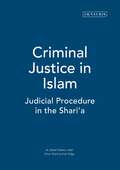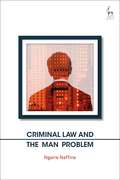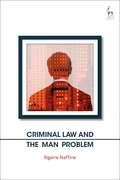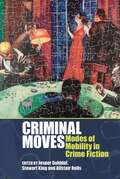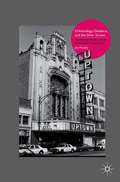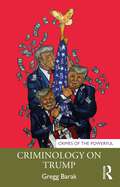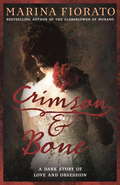- Table View
- List View
A Criminal Hero: Justice, Politics and Media Culture in Eighteenth-Century Naples (ISSN)
by Pasquale PalmieriIn the spring of 1757, the Augustinian friar Leopoldo di San Pasquale was tried in Naples by the hierarchies of his own religious order on charges of financial fraud, heresy, and sexual immorality. He responded by accusing the heads of the convent of subjecting him to a series of inhuman cruelties, claiming to have been "buried alive". While waiting for a final judgment (it was pronounced seven years later, in 1764), the trial of Leopoldo di San Pasquale became a cultural phenomenon unlike any witnessed before in Naples. Cumulatively, reactions to the trial, both during and after it, broke the boundaries separating chronicle and literary fiction, engaged people’s faculties of reason and emotion, and ultimately transformed Leopoldo into a public spectacle—or what we might call today a “celebrity.”Focusing on the scandalous affair of the "buried alive", this book shows how the governing authorities in Naples managed the development of news and stories around current events through their systems of courts and bureaucracies. It also aims to demonstrate how, just as importantly, consumers played an increasing in the spread of information, as means to political empowerment. The sources analyzed call for a microhistorical analysis, as well as for an interdisciplinary discussion with media studies at its conceptual core.A Criminal Hero will appeal to students and scholars alike interested in microhistory, cultural history, media history, history of literature, social and political history, with a focus on the eighteenth century.
Criminal Intimacy: Prison and the Uneven History of Modern American Sexuality
by Regina KunzelSex is usually assumed to be a closely guarded secret of prison life. But it has long been the subject of intense scrutiny by both prison administrators and reformers—as well as a source of fascination and anxiety for the American public. Historically, sex behind bars has evoked radically different responses from professionals and the public alike. In Criminal Intimacy, Regina Kunzel tracks these varying interpretations and reveals their foundational influence on modern thinking about sexuality and identity. Historians have held the fusion of sexual desire and identity to be the defining marker of sexual modernity, but sex behind bars, often involving otherwise heterosexual prisoners, calls those assumptions into question. By exploring the sexual lives of prisoners and the sexual culture of prisons over the past two centuries—along with the impact of a range of issues, including race, class, and gender; sexual violence; prisoners’ rights activism; and the HIV epidemic—Kunzel discovers a world whose surprising plurality and mutability reveals the fissures and fault lines beneath modern sexuality itself. Drawing on a wide range of sources, including physicians, psychiatrists, sociologists, correctional administrators, journalists, and prisoners themselves—as well as depictions of prison life in popular culture—Kunzel argues for the importance of the prison to the history of sexuality and for the centrality of ideas about sex and sexuality to the modern prison. In the process, she deepens and complicates our understanding of sexuality in America.
Criminal Intimacy: Prison and the Uneven History of Modern American Sexuality
by Regina KunzelSex is usually assumed to be a closely guarded secret of prison life. But it has long been the subject of intense scrutiny by both prison administrators and reformers—as well as a source of fascination and anxiety for the American public. Historically, sex behind bars has evoked radically different responses from professionals and the public alike. In Criminal Intimacy, Regina Kunzel tracks these varying interpretations and reveals their foundational influence on modern thinking about sexuality and identity. Historians have held the fusion of sexual desire and identity to be the defining marker of sexual modernity, but sex behind bars, often involving otherwise heterosexual prisoners, calls those assumptions into question. By exploring the sexual lives of prisoners and the sexual culture of prisons over the past two centuries—along with the impact of a range of issues, including race, class, and gender; sexual violence; prisoners’ rights activism; and the HIV epidemic—Kunzel discovers a world whose surprising plurality and mutability reveals the fissures and fault lines beneath modern sexuality itself. Drawing on a wide range of sources, including physicians, psychiatrists, sociologists, correctional administrators, journalists, and prisoners themselves—as well as depictions of prison life in popular culture—Kunzel argues for the importance of the prison to the history of sexuality and for the centrality of ideas about sex and sexuality to the modern prison. In the process, she deepens and complicates our understanding of sexuality in America.
Criminal Irish Drunkards: The Inebriate Reformatory System 1900-1920
by Conor ReidyOffering a unique insight into the habitual inebriate offender class in Ireland, this book examines the inebriate reformatory system in Ireland from its foundation in 1900 until its closure in 1920 and the three institutions charged with punishing or rehabilitating habitual drunkards: The State Inebriate Reformatory, The Certified Inebriate Reformatory and The Voluntary Inebriate Retreat. Using registers of inmates, annual reports, court cases and institutional records, Conor Reidy presents a stark account of the ways in which alcohol addiction and lack of opportunity condemned countless Irish victims to lives of poverty, misery and crime in the early twentieth century. The author also looks at the ways in which institutional staff sought to exact reform over the inmates through education, training, religion and discipline. This book profiles a hitherto little-known system, giving it a place within the historiography of Ireland’s complex web of so-called reformative institutions.
Criminal Justice During the Long Eighteenth Century: Theatre, Representation and Emotion
by David Lemmings Allyson N. MayThis book applies three overlapping bodies of work to generate fresh approaches to the study of criminal justice in England and Ireland between 1660 and 1850. First, crime and justice are interpreted as elements of the "public sphere" of opinion about government. Second, "performativity" and speech act theory are considered in the context of the Anglo-Irish criminal trial, which was transformed over the course of this period from an unmediated exchange between victim and accused to a fully lawyerized performance. Thirdly, the authors apply recent scholarship on the history of emotions, particularly relating to the constitution of "emotional communities" and changes in "emotional regimes".
Criminal Justice During the Long Eighteenth Century: Theatre, Representation and Emotion
by David Lemmings Allyson N. MayThis book applies three overlapping bodies of work to generate fresh approaches to the study of criminal justice in England and Ireland between 1660 and 1850. First, crime and justice are interpreted as elements of the "public sphere" of opinion about government. Second, "performativity" and speech act theory are considered in the context of the Anglo-Irish criminal trial, which was transformed over the course of this period from an unmediated exchange between victim and accused to a fully lawyerized performance. Thirdly, the authors apply recent scholarship on the history of emotions, particularly relating to the constitution of "emotional communities" and changes in "emotional regimes".
Criminal Justice in Islam: Judicial Procedure in the Shari'a
by Kate DanielsWhere do Islamic courts still operate in the modern world? What training does an Islamic judge receive? How does an Islamic court deal with a criminal case? What proof and evidence does it accept? What penalties may an Islamic judge impose in criminal matters? What law and practice do the Islamic judges apply to transgressions by Westerners in Saudi Arabia, whether they be accused of murder, adultery or drinking alcohol?This book attempts to answer all the above crucial, basic yet difficult questions of Islamic law. A formidable array of judicial talent considers all aspects of Islamic criminal procedure with the firm emphasis on its practical application in modem states today. Controversial cases are dealt with and explained from an Islamic point of view with the aim of informing a Western audience of the objectivity and fair process inherent in the Islamic system.
Criminal Law and the Man Problem
by Ngaire NaffineMen have always dominated the most basic precepts of the criminal legal world – its norms, its priorities and its character. Men have been the regulators and the regulated: the main subjects and objects of criminal law and by far the more dangerous sex. And yet men, as men, are still hardly talked about as the determining force within criminal law or in its exegesis. This book brings men into sharp focus, as the pervasively powerful interest group, whose wants and preoccupations have shaped the discipline. This constitutes the 'man problem' of criminal law.This new analysis probes the unacknowledged thinking of generations of influential legal men, which includes the psychological and legal techniques that have obscured the operation of bias, even to the legal experts themselves. It explains how men's interests have influenced the most cherished legal norms, especially the rules of human contact, which were designed to protect men from other men, while specifically securing lawful sexual access to at least one woman. The aim is to test the discipline's broadest commitments to civility, and its trajectory towards the final resolution, when men and women were declared to be equal and equivalent legal persons. In the process it exposes the morally and intellectually limiting consequences of male power.
Criminal Law and the Man Problem
by Ngaire NaffineMen have always dominated the most basic precepts of the criminal legal world – its norms, its priorities and its character. Men have been the regulators and the regulated: the main subjects and objects of criminal law and by far the more dangerous sex. And yet men, as men, are still hardly talked about as the determining force within criminal law or in its exegesis. This book brings men into sharp focus, as the pervasively powerful interest group, whose wants and preoccupations have shaped the discipline. This constitutes the 'man problem' of criminal law.This new analysis probes the unacknowledged thinking of generations of influential legal men, which includes the psychological and legal techniques that have obscured the operation of bias, even to the legal experts themselves. It explains how men's interests have influenced the most cherished legal norms, especially the rules of human contact, which were designed to protect men from other men, while specifically securing lawful sexual access to at least one woman. The aim is to test the discipline's broadest commitments to civility, and its trajectory towards the final resolution, when men and women were declared to be equal and equivalent legal persons. In the process it exposes the morally and intellectually limiting consequences of male power.
Criminal Liverpool (Criminal Ser.)
by Daniel K LongmanCriminal Liverpool is an entertaining and informative round-up of some of the strangest, most bloodthirsty, despicable and comical crimes that took place in and around Liverpool from the Victorian era up to the mid-twentieth century. Daniel Longman's painstaking research has uncovered many cases that have been long forgotten, and sheds new light on local cause celebres. The readable text is supported by seventy-five fascinating illustrations and will appeal to anyone who has an interest in the darker side of the city's history.
Criminal Moves: Modes of Mobility in Crime Fiction (Liverpool English Texts and Studies #78)
Criminal Moves: Modes of Mobility in Crime Fiction offers a major intervention into contemporary theoretical debates about crime fiction. It seeks to overturn the following preconceptions: that the genre does not warrant critical analysis, that genre norms and conventions matter more than textual individuality, and that comparative perspectives are secondary to the study of the British-American canon. Criminal Moves challenges the distinction between literary and popular fiction and proposes that crime fiction be seen as constantly violating its own boundaries. Centred on three axes of mobility, the essays ask how can we imagine a mobile reading practice that realizes the genre’s full textual complexity, without being limited by the authoritative self-interpretations provided by crime narratives; how we can overcome restrictive notions of ‘genre’, ‘formula’ or ‘popular’; and how we can establish transnational perspectives that challenge the centrality of the British-American tradition and recognize that the global history of crime fiction is characterized, not by the existence of parallel national traditions, but rather by processes of appropriation and transculturation. Criminal Moves presents a comprehensive reinterpretation of the history of the genre that also has profound ramifications for how we read individual crime fiction texts.
Criminal Subculture in the Gulag: Prisoner Society in the Stalinist Labour Camps (Library of Modern Russia)
by Mark VincentDespite growing academic interest in the Gulag, our knowledge of the camps as a lived experience remains relatively incomplete. Criminal Subculture in the Gulag, in its sophisticated analysis of crime, punishment and everyday life in Soviet labour camps, rectifies this. From Gulag journals and song collections to tattoo drawings and dictionaries of slang, Mark Vincent draws on often-overlooked archival material from the Moscow Criminological Bureau to reconstruct a fuller picture of Gulag daily life and society. In thematic chapters, Vincent maps the Gulag 'penal arc' of prisoners across initiation tests, means of communication, the importance of card playing, punishment rituals and the notorious 1948-52 cyka ('bitches') internal prison war between military veterans and vory-v-zakone. Most importantly, this timely examination of crime and punishment in modern Russia also highlights the lines of continuity between the Gulag systems, late Imperial Katorga,and today's Russian mafia. As such, this impressively interdisciplinary volume is important reading for all scholars of 20th-century Russia as well as those interested in international criminality and penology.
Criminal Subculture in the Gulag: Prisoner Society in the Stalinist Labour Camps (Library of Modern Russia)
by Mark VincentDespite growing academic interest in the Gulag, our knowledge of the camps as a lived experience remains relatively incomplete. Criminal Subculture in the Gulag, in its sophisticated analysis of crime, punishment and everyday life in Soviet labour camps, rectifies this. From Gulag journals and song collections to tattoo drawings and dictionaries of slang, Mark Vincent draws on often-overlooked archival material from the Moscow Criminological Bureau to reconstruct a fuller picture of Gulag daily life and society. In thematic chapters, Vincent maps the Gulag 'penal arc' of prisoners across initiation tests, means of communication, the importance of card playing, punishment rituals and the notorious 1948-52 cyka ('bitches') internal prison war between military veterans and vory-v-zakone. Most importantly, this timely examination of crime and punishment in modern Russia also highlights the lines of continuity between the Gulag systems, late Imperial Katorga,and today's Russian mafia. As such, this impressively interdisciplinary volume is important reading for all scholars of 20th-century Russia as well as those interested in international criminality and penology.
Criminal Wirral II
by Daniel K LongmanThis fascinating new volume is a follow-up to Daniel K. Longman's first book Criminal Wirral; an intriguing and entertaining collection of some of the strangest, most despicable and comical crimes that took place on the Wirral peninsula throughout the Victorian era and the early twentieth century. The tales featured here uncover many fascinating cases that have been long forgotten, and are supported by illustrations which help to bring these events and the people featured in them to life. Read on and uncover the grisly facts of what once lay floating in Birkenhead Park pond, a gruesome suicide on board a Woodside-bound locomotive and the farcical actions of a drunken butler one night at the stately Thurstaston Hall Criminal Wirral II will appeal to anyone who has an interest in the darker side of Wirral's history.
The Criminalization of Abortion in the West: Its Origins in Medieval Law
by Wolfgang P. MüllerAnyone who wants to understand how abortion has been treated historically in the Western legal tradition must first come to terms with two quite different but interrelated historical trajectories. On one hand, there is the ancient Judeo-Christian condemnation of prenatal homicide as a wrong warranting retribution; on the other, there is the juristic definition of "crime" in the modern sense of the word, which distinguished the term sharply from "sin" and "tort" and was tied to the rise of Western jurisprudence. To find the act of abortion first identified as a crime in the West, one has to go back to the twelfth century, to the schools of ecclesiastical and Roman law in medieval Europe.In this book, Wolfgang P. Müller tells the story of how abortion came to be criminalized in the West. As he shows, criminalization as a distinct phenomenon and abortion as a self-standing criminal category developed in tandem with each other, first being formulated coherently in the twelfth century at schools of law and theology in Bologna and Paris. Over the ensuing centuries, medieval prosecutors struggled to widen the range of criminal cases involving women accused of ending their unwanted pregnancies. In the process, punishment for abortion went from the realm of carefully crafted rhetoric by ecclesiastical authorities to eventual implementation in practice by clerical and lay judges across Latin Christendom. Informed by legal history, moral theology, literature, and the history of medicine, Müller’s book is written with the concerns of modern readers in mind, thus bridging the gap that might otherwise divide modern and medieval sensibilities.
Criminalrecht und Criminaljustiz in Süd- und Neuostpreussen 1793-1806/07 (Reihe Rechtswissenschaft #204)
by Christian Brich„Die beiden Gefängnisse … sind dagegen unsicher, weil die eisernen Fenstergitter darinnen fehlen.“ Der Grund: der Kostenanschlag wäre beim Bau überschritten worden, so der BauConducteur. Was heute wie eine Groteske wirkt, war zwischen 1793 und 1806/07 in Süd- und Neuostpreußen, den Gebieten um Posen und Warschau bis hoch in das heutige Litauen, die im Rahmen der 2. und 3. Polnischen Teilung vorübergehend an Preußen gefallen waren, Realität.Christian Brich gibt anhand vieler Originalquellen ein anschauliches Bild des Criminalrechts und der Criminaljustiz zum Ende des 18. Jahrhunderts, das nicht nur Juristen, sondern auch jeden Preußenfan und Historiker interessieren dürfte. Neben der Gesetzgebung werden weitere Aspekte des Justiwesens, von der Einrichtung der Gerichte, über den damaligen Inquisitionsprozess, bis hin zu den Zucht- und Besserungsanstalten und der Auswahl des Personals, dargestellt. So überrascht es dann nicht, dass auch ein Regierungsassessor in Posen namens E.T.A. Hoffmann seine Erwähnung findet. Unser heutiges, mitteleuropäisches Verständnis von Kriminalrechtspflege ist ein anderes als dasjenige vor 200 Jahren. Zur Verdeutlichung werden maßgeblich Begriffe in damaliger Schreibweise verwandt. Doch viele Probleme, denen sich der preußische Staat damals stellen musste, namentlich das der Finanzierung des Strafvollzuges, wirken auch heute noch beklemmend aktuell.
A Criminological Imagination: Essays on Justice, Punishment, Discourse
by Pat CarlenA Criminological Imagination contains a selection of key articles from Pat Carlen's research studies of magistrates' courts and women's imprisonment together with a range of other articles on social control, discourse analysis, ideology, punishment, criminology and critique. They are all informed by an assumption that while criminal justice must remain imaginary in societies based upon unequal and exploitative social relations, one task of a criminological imagination might be to suggest why this is so, and how things could be otherwise. This is an invaluable collection for anyone interested in crime, justice and injustice and the social, political and academic contexts in which knowledge of them is constructed.
A Criminological Imagination: Essays on Justice, Punishment, Discourse (Pioneers In Contemporary Criminology Ser.)
by Pat CarlenA Criminological Imagination contains a selection of key articles from Pat Carlen's research studies of magistrates' courts and women's imprisonment together with a range of other articles on social control, discourse analysis, ideology, punishment, criminology and critique. They are all informed by an assumption that while criminal justice must remain imaginary in societies based upon unequal and exploitative social relations, one task of a criminological imagination might be to suggest why this is so, and how things could be otherwise. This is an invaluable collection for anyone interested in crime, justice and injustice and the social, political and academic contexts in which knowledge of them is constructed.
Criminology: A Critical Overview
by Ezzat A. FattahWritten by an internationally renowned authority in the field, the founder of the highly regarded School of Criminology at Simon Fraser University, the book draws heavily on research done on three Continents: North America, Europe and Australia, to trace the discipline's historical evolution, its current problems, disappointing achievements, and promising trends. It concludes with a prospective look at the future of criminology and criminology of the future. Although the perspective is critical, the author's critique is constructive and he expresses a healthy optimism about the discipline's future and offers several guidelines as to how current deficiencies could be remedied and present gaps could be addressed.
Criminology, Deviance, and the Silver Screen: The Fictional Reality and the Criminological Imagination
by J. FrauleyThis text argues for the usefulness of fictional realities for criminological theorizing and analysis. It illustrates that a creative and critical social scientific practice requires craft norms rather than commercial norms that threaten to completely colonize higher education.
The Criminology of War
by Ruth JamiesonThe essays selected for this volume provide an overview of the range of issues confronting scholars interested in the complex and multiple relationships between war and criminality, and map the many connections between war, security, governmentality, punishment, gender and crime. The collection draws on the recent theoretical advances made by both criminologists and scholars from cognate disciplines such as law, politics, anthropology and gender studies, in order to open out criminological thinking about what war is, how it is related to crime and how these war/crime relationships reach into peace. The volume features contributions from key thinkers in the field and serves as a valuable resource for academics and students with an interest in the criminology of war.The essays selected for this volume provide an overview of the range of issues confronting scholars interested in the complex and multiple relationships between war and criminality, and map the many connections between war, security, governmentality, punishment, gender and crime. The collection draws on the recent theoretical advances made by both criminologists and scholars from cognate disciplines such as law, politics, anthropology and gender studies, in order to open out criminological thinking about what war is, how it is related to crime and how these war/crime relationships reach into peace. The volume features contributions from key thinkers in the field and serves as a valuable resource for academics and students with an interest in the criminology of war.
The Criminology of War (International Library Of Criminology, Criminal Justice And Penology - Second Ser. #2)
by Ruth JamiesonThe essays selected for this volume provide an overview of the range of issues confronting scholars interested in the complex and multiple relationships between war and criminality, and map the many connections between war, security, governmentality, punishment, gender and crime. The collection draws on the recent theoretical advances made by both criminologists and scholars from cognate disciplines such as law, politics, anthropology and gender studies, in order to open out criminological thinking about what war is, how it is related to crime and how these war/crime relationships reach into peace. The volume features contributions from key thinkers in the field and serves as a valuable resource for academics and students with an interest in the criminology of war.The essays selected for this volume provide an overview of the range of issues confronting scholars interested in the complex and multiple relationships between war and criminality, and map the many connections between war, security, governmentality, punishment, gender and crime. The collection draws on the recent theoretical advances made by both criminologists and scholars from cognate disciplines such as law, politics, anthropology and gender studies, in order to open out criminological thinking about what war is, how it is related to crime and how these war/crime relationships reach into peace. The volume features contributions from key thinkers in the field and serves as a valuable resource for academics and students with an interest in the criminology of war.
Criminology on Trump (Crimes of the Powerful)
by Gregg BarakCriminology on Trump is a criminological investigation of the world’s most successful outlaw, Donald J. Trump. Over the course of five decades, Donald Trump has been accused of sexual assault, tax evasion, money laundering, non-payment of employees, and the defrauding of tenants, customers, contractors, investors, bankers, and charities. Yet, he has continued to amass wealth and power. In this book, criminologist and social historian Gregg Barak asks why and how?This book examines how the United States precariously maintains stability through conflict in which groups with competing interests and opposing visions struggle for power, negotiate rule breaking, and establish criminal justice. While primarily focused on Trump’s developing character over three quarters of a century, it is also an inquiry into the changing cultural character and social structure of American society. It explores the ways in which both crime and crime control are socially constructed in relation to a changing political economy.An accessible and compelling read, this book is essential for all those who seek a criminological understanding of Donald Trump’s rise to power.
Criminology on Trump (Crimes of the Powerful)
by Gregg BarakCriminology on Trump is a criminological investigation of the world’s most successful outlaw, Donald J. Trump. Over the course of five decades, Donald Trump has been accused of sexual assault, tax evasion, money laundering, non-payment of employees, and the defrauding of tenants, customers, contractors, investors, bankers, and charities. Yet, he has continued to amass wealth and power. In this book, criminologist and social historian Gregg Barak asks why and how?This book examines how the United States precariously maintains stability through conflict in which groups with competing interests and opposing visions struggle for power, negotiate rule breaking, and establish criminal justice. While primarily focused on Trump’s developing character over three quarters of a century, it is also an inquiry into the changing cultural character and social structure of American society. It explores the ways in which both crime and crime control are socially constructed in relation to a changing political economy.An accessible and compelling read, this book is essential for all those who seek a criminological understanding of Donald Trump’s rise to power.
Crimson and Bone: A Dark Story Of Love And Obsession
by Marina Fiorato'A rich jewel of a story, full of desire and danger' - Julie Cohen. A dark tale of love and obsession, perfect for fans of The Mermaid and Mrs Hancock and The Wicked Cometh. London, 1853. Annie Stride has nothing left to live for - she is a penniless prostitute, newly evicted from her home and pregnant. On the night she plans to cast herself from Waterloo Bridge into the icy waters of the Thames, her life is saved by Francis Maybrick Gill, a talented pre-Raphaelite painter - and her world is changed forever.Francis takes Annie as his artist's muse, elevating her from fallen woman to society's darling. With her otherworldly beauty now the toast of London, her dark past is left far behind. But Annie's lavish new life is not all it seems - and there are some who won't let her forget where she came from...'A thrilling tale of love, lust and revenge' The Lady'A captivating gothic blend of mystery and romance' Sunday Mirror'Exquisite...this is historical fiction at its best' - Book Literarti Reviews'Gothic, dark [and] rich with atmosphere' - Louise Loves books'A glorious story of art and passion' - Tea Party Princess'Dazzling' Goodreads Reviewer'Captivating' Goodreads Reviewer




